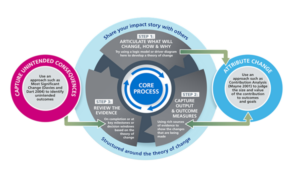Impact Framework
Overview of the Impact Framework
As part of NHS England’s role supporting large scale change programmes, the Impact Framework has been developed to systematically capture the impact of these programmes of work. The Impact Framework has been developed based on approaches used by others in the field of developmental evaluation, tailored to support improvement work in complex systems.
Watch our animation with an overview of the Impact Framework.
An online guide provides a practical resource for anyone who may be looking to apply the Impact Framework to their own work. It can be found on the AnalystX FutureNHS pages: Impact Framework How to Guide – AnalystX – FutureNHS Collaboration Platform.
More information about the Impact Framework can also be found in a recent publication: Willett et al, Telling the story of complex change: an Impact Framework for the real world, International Journal for Quality in Health Care, Volume 33, Issue 3, 2021, mzab090, https://doi.org/10.1093/intqhc/mzab090
What do we mean by impact and value?
We are thinking about impact and value in terms of their everyday, dictionary definition usage:
- Impact: A marked effect or influence. For example, ‘our regional measures have had a significant impact on unemployment’
- Value: The regard that something is held to deserve; the importance, worth, or usefulness of something
Why is it important to evidence impact and value?
- To justify spend
- To provide assurances to sponsors, commissioners and stakeholders
- It’s an essential element of all improvement work
- To maximise our likelihood of success
- To capture the true benefits felt by people
- To capture learning to inform future work
Why is it hard to evidence impact and value?
- Traditional approaches can underestimate impact and value
- Focus on spend can lead to us to missing some aspects of value
- System change has multiple players
- System change takes time
- Capturing and using evidence well takes expertise and confidence
- We tend to have a culture of ‘getting on with it’
How the Impact Framework works
The Impact Framework draws heavily on established theory behind improvement methodology, so it utilises a cyclical or iterative approach, which is represented in the diagram below. Each of the steps are inter-related and it is expected that each programme of work would undergo several cycles during its lifetime.
The underpinning principles:
- Be clear about what you are trying to achieve and understand what changes
- There is no one absolute measure of value- focus on creating a good enough account of value at a point in time
- Judgements of value can, and should be made by those involved in the work, not just third party ‘objective’ evaluators
- Involve stakeholders in defining and evaluating value at meaningful intervals
- Be honest about contribution and attribution
- Don’t dismiss the elements of value which are harder to capture
- Keep it simple and transparent
- Focus on learning, not just accountability
Pages in this how to guide
See the links below for more information and to learn more about how to carry out each step.
- Step 1: Articulate what will change, how and why
- Step 2: Capture evidence
- Step 3: Review the evidence
- Step 4: Share your impact with others
Optional steps
- Capture unintended consequences
- Attribute change

